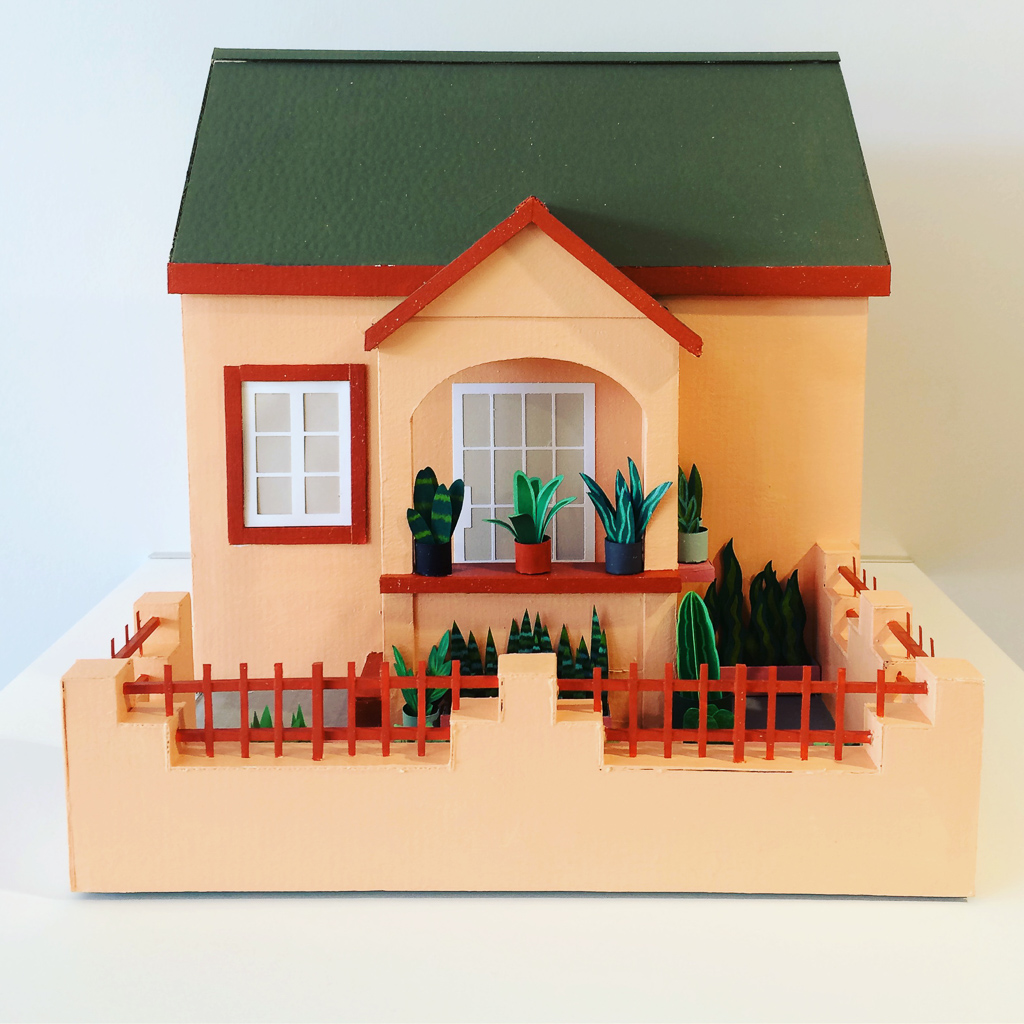Ana Serrano’s Urban Oases
Words by Marc Haefele, Senior Arts Writer, Bermudez Projects
So charming and evocative are Ana Serrano’s creations that you want to knock on their little doors, then peer inside – curious at what they may contain. Serrano terms them sculpture. You might call them “habitations.” They are 2-dimensional friezes and 3-dimensional tiny model homes, all in the vivid hues of tropical flora that characterize the homelands of those who came to L.A. from south of the U.S. border.
They cannot but remind you of New Yorker Joseph Cornell’s famous “boxes.” They have Cornell’s charm and sense of combined purpose and bafflement.
But while Cornell’s creations are all about insides, Serrano’s little assemblages and dwellings are all externals, the conceived outsides of typical immigrant homes. The title from her recent exhibit at Bermudez Projects, La Yarda, Spanglish for “The Front Yard,” connotes that Serrano’s goal is to stress the combined social and private aspects of the narrow outside space, usually paved, that front these homes in their honeydew, mango and other equatorial colors.
Says Serrano: “Where they came from, the immigrants generally had plenty of land to spread out in, to plant trees and vegetables in; here they’re confined to the small space outside of their Eastside homes. So they make the most of the space they have.”
Nor is it just the Eastside. “In Highland Park; even in Mid-City, almost every part of L.A., you can catch glances of streets of these brightly colored little houses,” Serrano added. They often belong to the people most other Angelenos tend to ignore or overlook.
But Serrano’s specific imagery is all imaginary, she says. “There are elements in them of the many local houses and other small buildings I’ve known all my life,” the L.A. native adds. The original buildings, she notes, are quite mutable – a house may become a store. A windowless tienda (store) may be transformed into a home. She also knows the lifestyles they contain, which by implication spill out into the gray-surfaced front yards, with their imitation cinder block and wrought iron fences.
Serrano’s barrio-urban landscape is a tribute to her family connection with Mexico and of the domiciliary individuality of the immigrant community, which has taken over the modest suburbs that once belonged to earlier working class generations. Now they reflect colors, taste, vegetation and culture of their community’s homeland to the South.
The homes and other buildings represent the modest conceptual and architectural variety of the original developers’ designs. But the distinctions have been largely homogenized by the wide application of the typical L.A. sprayed-on stucco (the brand is usually Texture Coat) that now conceals most of the original exteriors – which Serrano has meticulously duplicated. Along with telling details like window bars, a portrait of the Virgin Mary in a window, an above-ground pool, ready for splashing children, sits with the hose that just now filled it lying nearby. Then there are the myriad potted plants – mostly tall, narrowing succulents, which, in her view, approximate the lost rural landscape of the country left behind.
“I used to love to play with the Cola de Caballo when I was a child,” Serrano recalls. The barrio kids could be hard on the plants, she says, but like the children themselves, they survived. Plants are depicted in brightly figured pots outside the homes, or stand as themselves – as with the constructed Palm Tree, Cactus, and that Cola de Caballo, the ubiquitous, dark green horse-tail succulent.
Serrano creates her vivid imaginings with homely materials including glue, bright acrylic paint, paper, and the cardboard that she sometimes scavenges herself. Her Homegrown installation at the Pasadena Museum of California Art offered expanded close-ups of the subjects seen in La Yarda, plus a look at her creative methodology.
Serrano says she wanted to portray “the cultural norms around using the front yard as a social space.”
Serrano’s work demonstrates that, in the Barrio, la yarda is where private space gives way to neighborhood collectivity, where the Latino household blends into the culture itself.
And, in Serrano’s hands, it flows effortlessly into the greater culture of all of California.
All images courtesy of the artist and Bermudez Projects, Los Angeles. © 2018. All rights reserved.






